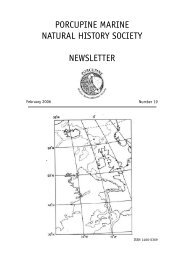Porcupine Newsletter Number 25, Winter 2008/09.
Porcupine Newsletter Number 25, Winter 2008/09.
Porcupine Newsletter Number 25, Winter 2008/09.
Create successful ePaper yourself
Turn your PDF publications into a flip-book with our unique Google optimized e-Paper software.
up around the British Isles. Records from theUK Marine Fish Recording Scheme managedby the National Marine Aquarium in Plymouthshow that this is the second Blue Marlin tobe recorded from British and Irish waters andonly the fourth billfish (the first in Wales).The first UK Blue Marlin was a specimen of 3.7metres found dead on a beach on St Agnes inthe Isles of Scilly in March 1982. A 1.8 metrelong White Marlin was found alive but dying inMorecambe Bay in August 1983, and a Sailfishof 2.66 metres was washed up at the mouthof the River Yealm in South Devon back inAugust 1926.Douglas Herdson, Information Officerat the National Marine Aquarium, said “Thebillfish are incredible wanderers of the openoceans of the world, but prefer warmer watersthan ours. It is just the odd vagrant that straysinto our seas and comes to grief. They are veryunusual and it is a shame that this fish didnot go into a national collection such as thatof the National Museum of Wales.”“This is just a straggler and probably hasnothing to do with climate change, but in yearsto come if the sea temperatures continue toincrease they may become commoner aroundour shores, if the stocks have not been fisheddown to depletion.”The marlins and sailfish are powerfulwarm water ocean wanderers, migrating vastdistances each year, often favouring the blueclear waters. The warmer surface waters abovethe temperature change of the thermoclineare the normal hunting ground of the marlin,but they may dive to 350 metres in the searchfor prey. In the East Atlantic Blue Marlinnormally occurs as far north as southern Bayof Biscay.Sleek and muscular, they are the fastest offish reaching 100 kilometres per hour. Visualpredators that hunt by day they have evolveda wonderful anatomy that maintains the eyesand brain at a warm temperature so increasingtheir efficiency. The bill is an elongatedtoothless upper jaw whose purpose has longbeen debated, but recent studies have shownthat it is frequently used to slash, and evenspear, fish they feed on. They also target squidand octopus. They spawn in tropical regionsand move out to cooler latitudes in the hotterperiods of the year.Fishing pressures have reduced theirpopulations to a mere ten percent or less oftheir historic levels. Doug Herdson commented“The seas are a poorly known world of theirown and every so often they reveal some oftheir wonders. This just shows how muchwe should celebrate and protect our marinelife.”Note: Marlin are sometimes confused withSwordfish, which have a longer stouter bill.Swordfish are also “heavier” more rotund fishwith no pelvic fins and a single keel on theside of the tail base. Marlin have two keelson the side of the tail base and their pelvicfins are long and thin ones attached under the“throat”. The relative bulkiness and the depthof the body of the Welsh fish, in comparisonto the height of the dorsal (back) fin showsit to be a Makaira, a blue or black marlin, asopposed the more slender sailfish and whitemarlins. Opinion among experts varies as towhether there are one, two or three species ofMakaira. Hence it is difficult to distinguishbetween them from a photograph. The mostlikely one is the Blue Marlin Makaira nigricans,with an outside possibility of the Black MarlinMakaira indica.PMNHS <strong>Newsletter</strong> No.24 Summer <strong>2008</strong> 23








